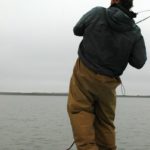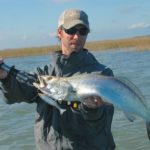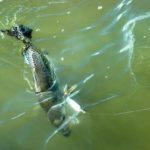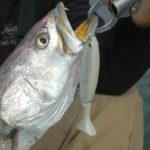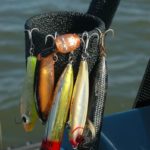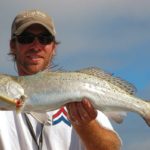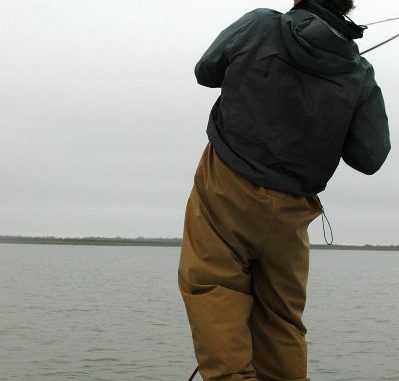
Sure, you can fight the crowd and load the boat with dink trout. But when you want to catch big fish, it’s time to find solitude and pull out topwaters and suspending lures.
At the mouth of the cove on the southwestern portion of Calcasieu Lake, Capt. Adam Jaynes slowed his Haynie Bay boat way, way down.
“All of this is a huge flat, and in several places there are some real nice reefs in here,” the 26-year-old angler said. “And look, there’s some mullet moving in front of us — moving really well.”
These were not the rafting schools of mullet most anglers cherish finding; they were of the single, jumping variety observed in most sections of any saltwater estuary at any given time of the day.
“These trout ought to be on the downcurrent side of this marsh flow, kind of out there on that point,” Jaynes said. “They’re waiting, just eager for their next meal to come by.”
Jaynes made at least 30 casts before the first explosion on top occurred.
“Ohhh — the fish wasn’t hooked,” he said, as his line went suddenly slack.
Fortunately, the angler kept working the clown Super Spook on its retrieve.
With the hard bait about halfway to the boat, the trout struck again — and immediately the angler was turning reel as his drag screamed in spurts.
“That trout came back!” Jaynes exclaimed. “He ate it, didn’t he?”
After a brief tryst with the fish, its sides gleaming in the slightly tainted waters, the fish was netted, weighed and photographed. It was pushing the 6-pound mark on Jayne’s Boga-Grip.
“There’s more in here, and we should get on them now,” he said after placing the hefty trout in the livewell.
After another 45 minutes, the angler had boated three more specks from that flat — two of them going over 6 pounds, and the other logging in at 5 ½ pounds.
And these better fish were taken after spending part of the morning at Turner’s Bay with 20 other boats taking many small, school trout and redfish under birds.
“Fishing for these better trout is my favorite activity at this time of the year,” he explained. “It’s certainly exciting catching school trout under birds, but hooking these big ladies on topwaters and suspending plugs is so much fun and special to me.”
Jaynes’ early memories of fishing conjure up the short rigs south of Grand Chenier, as well as the Mermentau River. He fished with his family for whatever was biting — mostly redfish in the Mermentau.
It was when fishing in Calcasieu Lake and nearby Sabine Lake that he began feverishly pursuing big speckled trout.
At Sabine Lake, he met and eventually mentored under Capt. Dickie Coburn to learn the western style of using plugs for big trout.
And now Jaynes is successful taking lunker trout — including loads of 5- to 7- pounders, and many 8s and 9s he terms the “big fish.”
Jaynes has a fondness for Heddon Super Spooks, dog-walking them in a combination of varying speeds and brief intermissions.
But Jaynes sports an unorthodox manner of working the rod when dog-walking topwaters.
“A lot of people work topwaters with their rod tips down,” he said. “For me personally, it’s uncomfortable. I’ve always worked that rod tip straight up and down.
“You can adjust how that topwater works left and right by varying the speed and the length of your sweep. If I want it to work wide left and right, I’ll retrieve it slow and pop the rod a little higher.”
He varies retrieve speed to coincide with the weather.
“I’ll work them pretty quick especially when it’s warm, and I will slow them down a little in colder waters,” Jaynes said. “But what’s most important is to experience how those trout want them — because the big fish can be peculiar about speed on any given day out here.
“I find that trout chiefly prefer topwaters in water temperatures of 60 degrees and above, and suspending plugs on waters with surface temperatures under 60 degrees.”
As for suspending hard baits, Jaynes uses the Egret Baits’ Kick A Mullet, the MirrOlure (formerly the Paul Brown) Corky Fat Boy and MirrOlure’s Catch 2000.
“All the hard baits I work are mullet imitators, and I use suspension plugs when I observe not much surface activity — or even under birds sometimes to catch larger trout mixed in schools of smaller fish,” Jaynes explained.
However, each of his suspending baits is worked just a little differently.
“I retrieve the Kick A Mullet very meticulously, slow rolling it and let that rattling tail push water by swaying it back and forth,” Jaynes said. “I’ll often count out the seconds — sometimes up to four (seconds) — letting it fall and then work it with slow twitches.”
He’s said the Corky requires a bit more attention.
“The Corky is one of those baits that you can have a tendency to overwork in cold waters, but it is also one that you can walk the dog with, as well,” Jaynes said. “And working it like that and keeping it right below the surface can be a real effective way of catching good fish.”
If he had to single out the most-important tool when throwing hard baits for these fish, Jaynes said it has to be the rod.
“I use a custom rod, a Sarge Custom, where you pick out all the elements of the rod to include the guides, the color of the thread and everything else,” he said. “It’s super light, at a mere 2 ½ ounces, and you end up with a lot less wrist fatigue from casting big baits all day.”
But there is another benefit of the rod.
“Since it’s so light, I can feel the most subtle taps or bites these big fish give, especially in cold water,” Jaynes said. “You’ll end up catching more fish with lighter, sensitive rods than you do with others.”
The rest of Jaynes’ equipment consists of 30-pound FINS Windtamer braided line with a 4-foot, 30-pound-test Berkley Big Game monofilament leader.
The guide said monofilament leaders are important for catching big trout because they add stretch to where it’s needed — on impact.
Editor’s note: Capt. Adam Jaynes can be reached at Just Fish Guide Service at 409-988-3901.
